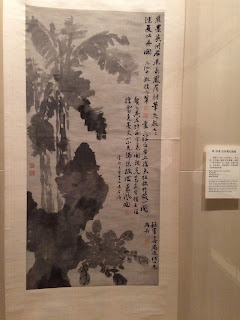The Shanghai Museum
The Shanghai Museum has many wonderful exhibitions like ancient bronze objects, pottery, money and its molds, and jade. The bronze artifacts come in many different sizes. The pretty pottery here has many forms and an explanation of their making. Most types of ancient coins may be strung on a string (except paper money). The jade has many designs.
 |
| Bells of Marquis Su of Jin mid 9th century B.C. |
 |
| Ding, a food vessel, with dragons and scale design (Late Spring and Autumn 6th century to 476 B.C.) |
This museum has bronze artifacts from every period in ancient China. It has food and wine vessels, and also early weapons. Bronze was also used to make some bells. These bells show an accurate version of the scales, from C to the C sharp an octave higher.
Some parts showed how to make items. This has the instructions to make a censer in the Han Dynasty (206 B.C. to 220 A.D.):
 |
| The gilt bronze censor with openwork interlaced dragon pattern |
Some parts showed how to make items. This has the instructions to make a censer in the Han Dynasty (206 B.C. to 220 A.D.):
- make a clay core,
- cover it in wax,
- carving the wax,
- make a wax stand with an interlaced dragon design,
- assemble wax runners and the model,
- cover it with clay,
- heat it until the wax melts (and drains out),
- pouring liquid bronze inside the runners,
- (when the bronze is solid) break the clay off.
Imagine how detailed the design is. The earliest lost wax castings were from the Spring and Autumn Period (771 to 476 B.C). This censer is from the Han Dynasty, about 270 years later.
 |
| Steps 1-4 |
 |
| Steps 4-8 |
 |
| Step 9 (step 10: the censor is complete) |
 |
| Tang three colors of a heavenly guardian Tang Dynasty (A.D. 618 to 907) |
 |
| A vase with an underglaze blue design Kangxi reign (1662-1722 A.D) Qing |
 |
An object made of jade
Qianlong reign (1736 to 1795 A.D) Qing
|
 |
A jade dragon
Warring States Period
475 to 221 B.C.
|
The jade here was very beautiful. It has many uses, like for ceremonies, ornaments, and for decoration. Some have even been shaped like weapons (but not used in wars)! Jade is so common in China it has been made into things we use daily. The dead often had bits of jade put inside their mouths, nose, and hands.
 |
| The blade of a jade axe (3200 to 2200 B.C.) |
Money from ancient China can still be found here. The coins come in many shapes and sizes. Some are circles with a square inside. Others remind me of a knife, though it can’t hurt anybody. We also saw paper money and an early form: seashells. Tablets in the same section as coins are actually molds used to make them!
 |
| Ancient coins |
The Shanghai Museum is one of the top museums in China. The Chinese bronzes have many different forms. The most popular form of the pottery inside is the Tang three color design. Coins could be made of many materials: copper, seashells, iron, paper, gold, and silver. This museum has a large collection of ancient Chinese art and famous calligraphy. It is full of exciting facts.



No comments:
Post a Comment